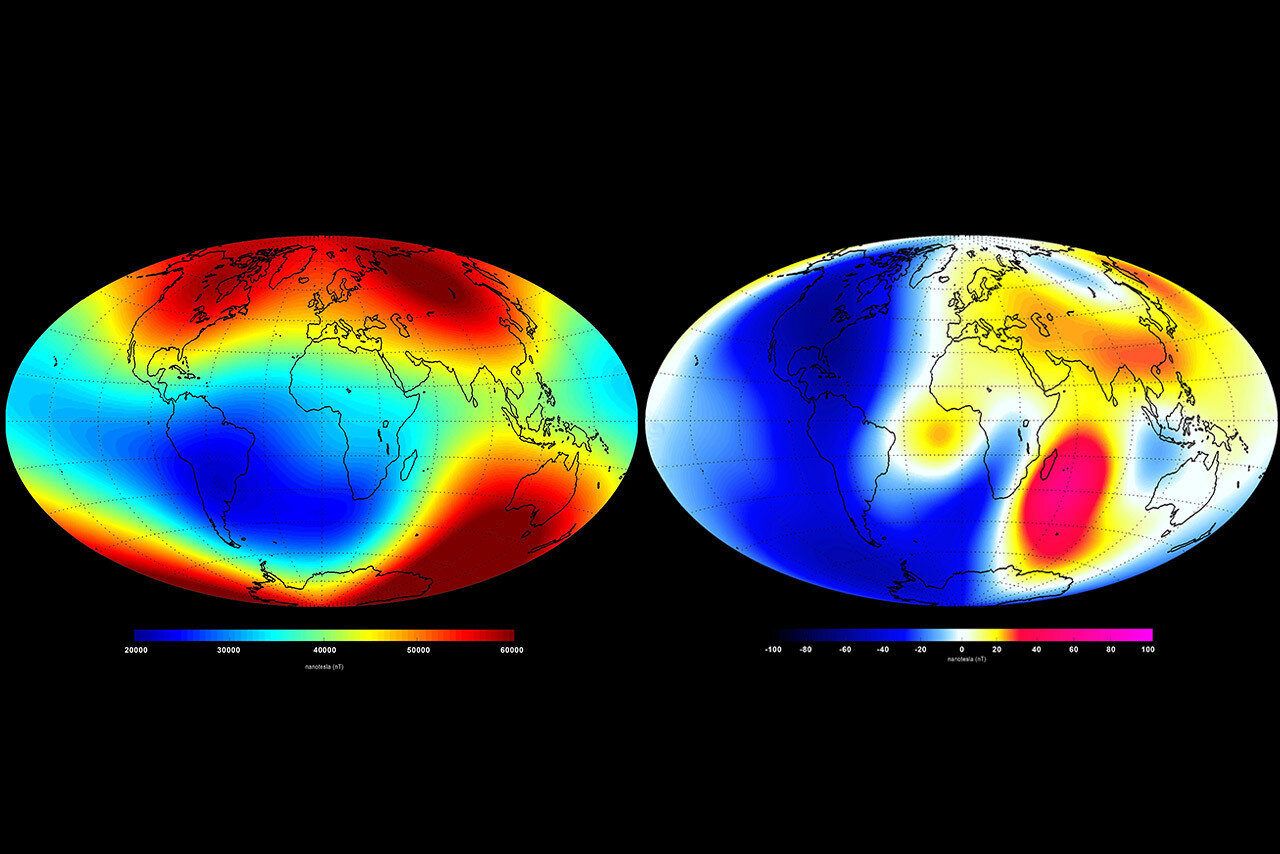Changes in Earth’s global magnetic field over six months in 2014 as measured by the European Space Agency’s three-satellite Swarm constellation. The left map shows the average magnetic field and the right shows the changes in magnetic field strength over this period. Courtesy: European Space Agency/Technical University of Denmark (ESA/DTU Space).
× near
Changes in Earth’s global magnetic field over six months in 2014 as measured by the European Space Agency’s three-satellite Swarm constellation. The left map shows the average magnetic field and the right shows the changes in magnetic field strength over this period. Courtesy: European Space Agency/Technical University of Denmark (ESA/DTU Space).
Earth’s liquid molten outer core, composed mostly of iron and nickel, exerts an electromagnetic field extending from the north and south poles that shields the planet from harmful solar particle radiation.
Fluctuations in the strength of the Earth’s magnetic field – caused by daily changes in the structure of the solar wind and periodic solar storms – can affect the use of geomagnetic field models that are essential for navigation in satellites, aircraft, ships and cars.
Magnetic field patterns differ depending on the location of data collection – either at or near the Earth’s surface or satellites in low Earth orbit. Previous research has attributed the differences in the patterns to activity levels of space weather, but a recent analysis of six years of Earth and satellite magnetic field models found that the pattern discrepancies are also due to modeling errors, not just geophysical phenomena. The results are published in Journal of Geophysical Research: Space Physics.
The University of Michigan research team evaluated the differences between observations from the Swarm mission’s low-Earth orbit satellites and the Earth’s magnetic field model, the thirteenth generation International Geomagnetic Field Reference, or IGRF-13. They focused on differences during low to moderate geomagnetic conditions, which covered 98.1% of the time between 2014 and 2020.
Satellite observations collected at various locations above Earth are sensitive to magnetic field fluctuations, while Earth magnetic field models use observations to estimate Earth’s internal magnetic field without accounting for the influence of solar storms. Internal magnetic field models such as IGRF-13 are used to track changes in Earth’s magnetic poles, such as the North Pole shifting about 45 km north-northwest each year.
Understanding these large differences is important for the operation of the satellite when using IGRF-13 as a reference and for studying the physics of the Earth’s magnetosphere, ionosphere, and thermosphere.
Model uncertainty is highest in the northern and southern polar regions, and statistical analysis reveals that the asymmetry between the northern and southern polar regions is a major factor leading to model differences.
“We often assume a nearly symmetric magnetic field between the north and south polar regions, but they are actually very different,” said Ying Shi, an assistant research scientist at the University of Michigan’s Department of Climate and Space Sciences and Engineering and corresponding author of the study.
The two geographic poles map to different geomagnetic coordinates. The north pole is mapped at about 84° magnetic latitude (MLAT) and 169° magnetic longitude (MLON), and the south pole is mapped at about −74° MLAT and 19° MLON.
The polar orbit track of the Swarm satellites creates a sampling bias with a high concentration of measurements around the geographic poles, exacerbating model differences.
“Understanding that what is attributed to geophysical disturbances is really due to the asymmetry of the Earth’s magnetic field will help us to better model the geomagnetic field, as well as help with satellite and aviation navigation,” said Mark Moldwin, the Arthur F. Turnau Professor of Climate and Space Science and Engineering at UM and an author of the study.
Another issue of concern to the navigational community is that the polar magnetic field has been changing rapidly over the past decade.
“This adds additional complexity to creating accurate magnetic field models,” Moldwin said.
More info:
Yining Shi et al, Nonphysical interhemispheric asymmetries in large magnetic field residuals between swarm observations and models of the Earth’s magnetic field during moderate to quiescent geomagnetic conditions, Journal of Geophysical Research: Space Physics (2024). DOI: 10.1029/2023JA032092



